#european fire-bellied toad
Explore tagged Tumblr posts
Text

Reptiles, Amphibia, Fishes and Lower Chordata. Written by Richard Lydekker and others. Illustration by J. Green. Published in 1912.
Internet Archive
155 notes
·
View notes
Text

European fire-bellied toad (Bombina bombina) By: Gerhard Budich From: Living Amphibians of the World 1966
51 notes
·
View notes
Text
1963 stamp from Poland featuring Protected Reptiles, here the European fire-bellied toad, Bombina bombina.

2 notes
·
View notes
Text
Among the most popular pet frogs, and among the most charming, are the fire-bellied frogs or toads - in the strictest sense, they aren't either - such as Bombina variegata, the yellow-bellied toad of the Western Palaearctic realm, and specifically Central and Southern Europe. This is a small and easily housed frog species, growing to a snout-to-vent length of 2.8 to 5.6 centimeters, or about 1 to 2 inches.
Within this species, racial differences exist in their markings across their geographical range. The northeastern populations are genetically distinct from their conspecifics in the rest of its distribution, to their west and their south. This deep divergence implies a pre-glacial common descent, and long isolation owed to climatic factors. For this species, the Carpathian Mountains were an ecological refuge, from uninhabitable Pleistocene climates. Also an Italian race of yellow-bellied toads, is often nowadays elevated to full species tank, as B. pachypus.
Bombina is a member of the costate frogs, a clade that also includes the well known genera Discoglossus and Alytes, the painted frogs and midwife toads. Costate frogs competently walk and hop, but they are not long-range jumpers. The costates are not only early diverging, but also protomorphic, retaining unspecialised pelvises that reflect their locomotor conservatism. It is the rearrangement of the pelvis in certain, unrelated frog clades, that allows such derived frogs to jump perfectly.
Bombina sp. are collectively known as the fire-bellied toads, because of their easily visible, yellow to red underbellies. As in those newts with a similar ventral coloration, this has evolved as an aposematic warning, or an advertisement of their toxicity to deter potential predators. To make obvious their coloration, these amphibians display their bellies when they are threatened by a larger carnivore, by flipping onto their own backs, or by employing the body language of raising up - this is the famous 'unken reflex'.
The species of Bombina are distributed from Europe across to Siberia and down beyond China. They are truly a Palaearctic faunal component, but their distribution is non-continuous, which is a result of ancient climate changes. There is an early divergence within the genus Bombina, separating a southern subclade, known as the B. maxima complex, and also a secondary division within the more northerly group, into the European group and the eastern B. orientalis.
At lower elevations, B. variegata lives in deciduous forests, whereas in higher terrain it is a denizen of conifer forests. A habitat generalist, B. variegata utilities diverse lentic and lotic waters. Relative to a sometimes sympatric Bombina species, B. bombina, it eats more terrestrial arthropods than aquatic prey in the wild. This fact allows for some niche partitioning where both species of Bombina are present in the wild.
Although the two species of fire bellied frog are quite distinctive in their looks and vocaluzations, they hybridize readily. However both morphospecies remain distinct, owing to natural selection disfavoring the fertile hybrids that result from these pairings. Thus in the case of these two Bombina species, racial mixing does not result in de-speciation through hybritity, nor has it resulted in the evolution of a new species from the hybrid stock.
B. variegata inhabits temperate, seasonal climates and the daily temperature it experiences, can shift by up to 10 degrees in the course of a day. A study of a B. variegata locality, found that the water temperature was 4 to 24 degrees centigrade, depending on the season. Whilst the air temperature there was 3-31 degrees. (At other localities where B. variegata is present, the water temperature may itself be 31 degrees.) Their season of activity begins at 8-10 degrees centigrade
B. variegata and other Bombina species need to have only shallow water provided for them, because they do not make deep dives for their food. Ideally, these anurans should be able to stand on their toes, reaching up so their faces are above the water. These anurans receive UV wavelengths as daylight in the wild, and benefit from a UVB emitting light source in the aquaterrarium. Bombina sp. do not damage live plants, and are thus suited to a planted aquaterrarium.
Some people have successfully cohabited Bombina sp. with other animals species, but there are risks. These frogs can reflexively lunge at animals that are perceived prey, and their glandular skins are themselves toxic, possibly creating problems should other animals come into contact with their skins. Nonetheless, similarly sized climbing animals, like tree frogs and anoles have been cohabited with Bombina sp. because they inhabit different areas of the enclosure, which minimizes interactions. Regarding conspecifics, male Bombina sp. may be aggressive to one another. The males of these frogs, have longer forearms than to the females.
However, on the down side, Bombina sp can (sometimes) be difficult to feed on a proper captive diet. Often, Bombina adapt to taking items such as floating sticks. Therefore it is untrue that their intended food needs to move, without which the feeding response cannot be stimulated. However, this does not mean that all individuals in these species, are equally willing to do so.
Non-living items in the water are more likely to elicit a feeding response, because chemosensory cues travel better through water than through air, however, contrary to popular factoids, it has also been argued for decades that frogs can see non-moving items, and recognize them as food. I am aware that frogs belonging to distantly related taxa, can and do eat pre-killed prey - these are costates, pipids, bufonids, hyloids, and ranoids.
It is widely reported, and I can see no reason to doubt it, that the species of Bombina differ in their temperature tolerances and optimums. All species of Bombina should be fine at cool room temperatures year round, in a cool temperate climate. That is to say, when and where it is suitable for humans to live comfortably, without feeling hot.
Despite being quite southern in its origin, the popular giant fire belly species, B. maxima from high altitudes in southern China, is said to require lower ambient temperatures, than do the European species. But I know for a fact that B. maxima can be acclimatized, like members of the more northern clade, to an ambient temperature of 24 or 25 degrees centigrade. And I am positive that these frogs encounter such temperatures, which are scarcely soaring, in their wild, subtropical latitude habitats.
Although the B. maxima species complex, which extends to Taiwan and northern Southeast Asia, include the largest of the fire bellied frogs, but even they are not huge. It is rare for individuals to exceed 6 and a 1/2 centimeters, or 2 and a 1/2 inches long. There is still systematic disagreement between herpetologists, as to which populations within this clade constitute separate species, or for that matter, the extent of the different species recognised within this phylogenetic nexus.
The archetypal fire-bellied frog, the European B. bombina, is less commonly encountered in exotic retail, than is the Oriental or Korean fire-belly, B. orientalis. This is a very similar animal to the western B. bombina, the European fire-belly, but the East Asian species has a distribution from the Amur region down to northern China. This is a popular species for those interested in studying animal behavior. It grows to 4 or 5 centimeters, or 1 and a 1/2 to 2 inches.
#Bombina variegata#yellow-bellied toad#fire-bellied toads#fire-bellied frogs#aquaterrarium pets#Bombina maxima#Bombina orientalis
1 note
·
View note
Text
Dj00011 European fire-bellied frog
Showing its bright colors when attacked, to signal: “Don’t eat me” Pencil research sketch Drawn note on Bombina bombina – European fire-bellied toad Drawing and text by Frits Ahlefeldt (Research pencil drawing ref: dj00011) Keywords: biodiversity, klokkefrø, Drawn journalism, research sketch, knowledge, pencil and watercolor

View On WordPress
1 note
·
View note
Photo

European fire-bellied toad
4 notes
·
View notes
Photo



European fire-bellied toad (Bombina bombina)
The European fire-bellied toad is a fire-bellied toad native to mainland Europe. European fire-bellied toads have a bright lime green dorsal traversed by black spots, and orange to bright red bellies with black bars and stripes. It is 26–60 mm long and may weigh 2-13.9 g. When they shed their skin, they bloat themselves and make a coughing sound, then start to tear the old skin off with their mouth, and eat it for nutrition, to reveal newer, brighter skin.The food of the European fire-bellied toad consists of insects, spiders, millipedes, mollusks and earthworms captured in or nearby the water.
photo credits: Marek Szczepanek, Christian Fischer
#european fire-bellied toad#bombina bombina#toad#zoology#biology#biodiversity#science#wildlife#nature#animals#cool critters
147 notes
·
View notes
Text

European Fire-Bellied Toad Bombina bombina
0 notes
Text
The 11 most venomous animals you can find in Germany
Ususlly you would think about exotic species when it comes to venomous animals, particularly species from Australia. Others are so common that they spontaneously don't come to our mind, such as bees, wasps, or hornets.
However, there are indeed venomous species that live in Germany, which can cause discomfort to severe pain, and – in rare cases – death.

Ammen-Dornfinger (Yellow Sac Spider), its fangs can penetrate the human skin and inject poison into the tissue. Symptoms are usually not worse than a bee sting, but can also cause nausea, vomiting, and shivers.
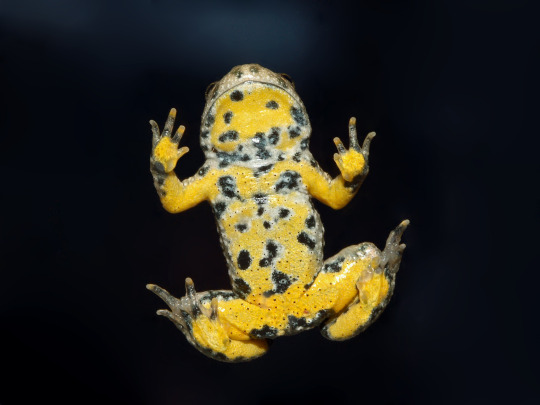
Gelbbauchunke (Yellow-Bellied Toad), the mucus contains a poison that is irritating to the skin and particulaly the mucosa and the eyes.
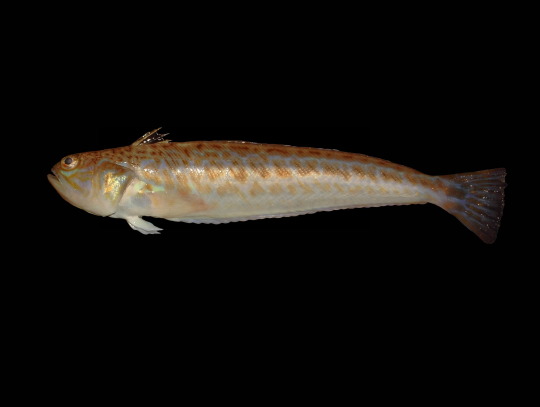
Petermännchen (Weeverfish), likes to bury itself in the ground near sandy beaches so that only the venomous spines stick out, causing a danger to the feet of tourusts. The symptoms include excruciating pain, swelling, redness, heat, neusea, vomiting, joint aches, headache, lightheadedness, increased urination, tremors, and in rare cases abnormal heart rhythm, seizures, gangrene, tissue degeneration, and unconciousness. This fish is considered the most dangerous venomous species that lives in Germany.
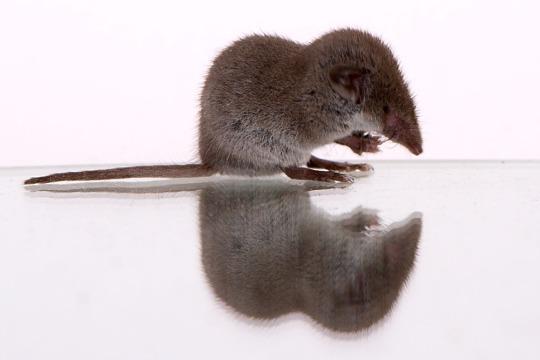
Spitzmäuse (Shrews) have venomous teeth. However, they rarely bite humans, and even more rarely have the power topenetrate the skin. They mostly use their venom to kill insects.

Kreuzotter (Common European Viper) are elusive animals, so very few peple have actually seen one. Their venom is three times more poisonous than that of the most dangerous rattlesnake. However, the viper doesn't like to waste its venom, that it also uses for hunting, for defense, and it has a much smaller reservoir. That's why the viper is only dangerous for small children and elderly people. Between 1959 and 2003, no viper-related deaths were recorded, and in 2004, an 81-year-old woman died. Victims often have to be hospitalized, about 10 % of them required ICU treatment. The symptoms include severe swelling, shortness of breath, and heart issues, in rere cases paralysis of the affected limb. On the other hand, numerous cases are known where the victims had no symptoms at all, probably because the viper didn't inject the venom.
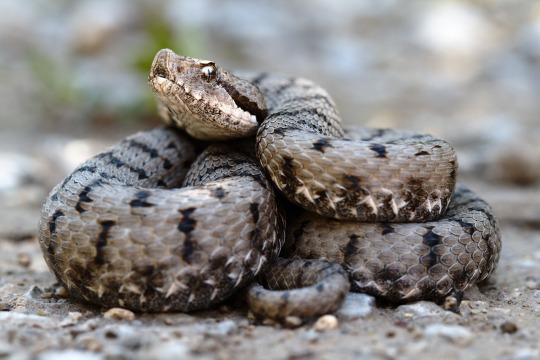
Aspisviper (Aspic Viper) occurs only in the southern parts of the Black Forest and is very rare. The venom is similar to that of the common viper. It is expected to expand its territory in the future due to global warming.
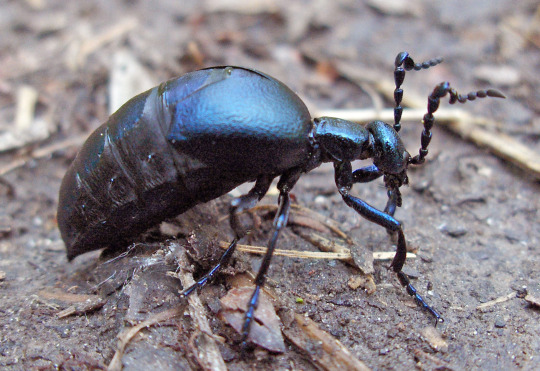
Schwarzblauer Ölkäfer (European Oil Beetle) sprays a substance that is severely irritant to eyes and mucosa.

Eichen-Prozessionsspinner (Oak Processionary), hairs of the larvae easily break off and float through the air. They contain a venom that causes symptoms that reach from mild urticaria to severe dermatitis. If inhaled, the hairs can cause bronchitis, painful cough, and asthma.
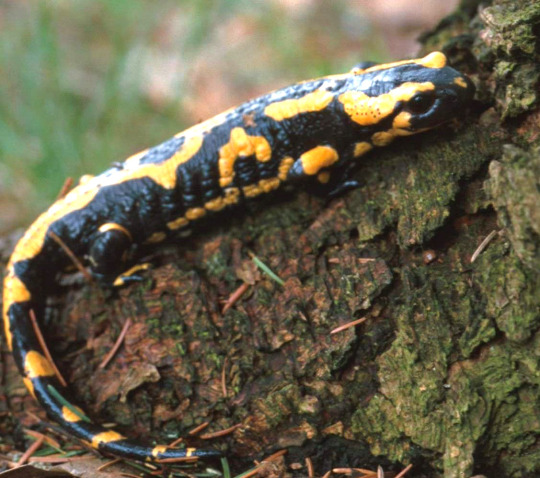
Feuersalamander (Fire Salamander) has venom on the surface of the skin. In humans, it causes a slightly burning sensation on the skin, but it is absolutely deadly for dogs.
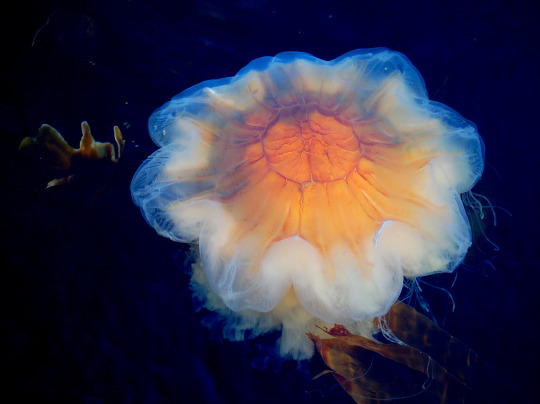
Gelbe Haarqualle / Feuerqualle (Lion's Mane Jellyfish): Touching this jellyfish causes excruciating pain, eczema, fever and breathing trouble.

Wasserspinne (Diving Bell Spider) can penetrate the human skin and inject venom. The effects are usually mild and not worse than a bee sting.
329 notes
·
View notes
Text
Pls Lower Decks my only wish is space dragons
So... remember how Spock has canonically seen dragons

[Image Descriptions are below the cut]
Most fans seem to forget (probably because this information was way less wild than space flower pollen turning him straight in that episode) BUT DRAGONS EXIST ON BARENGARIUS VII
T’Pol also mentioned these in Enterprise and says they breathe fire, but we never got to see them. Still, there were a bunch of other dragons in TAS (which is arguably canon) since it could get more creative with aliens/sets than the live-action shows



These days live-action Trek actually has a proper cgi budget but... it takes itself a bit too seriously for dragons. Lower Decks embraces the weirdness and is exactly the kind of show you’d expect an obscure callback from
My point is that Lower Decks could totally show us these forbidden space dragons and it’s probably never happening but I have been dying to know what they look like for years
[Image Description for picture 1: four screenshots from the episode “This Side of Paradise” arranged in one picture. Spock lies in Leila’s lap in a sunny field. They look up at the clouds together and talk.
Spock, pointing up: “You see the tail and the dorsal spines?”
Leila: “I’ve never seen a dragon”
Spock puts down his arm.
Spock: “I have.”
A communicator beeps but they both ignore it.
Spock: “On Barengarius 7.”
It beeps again and they still ignore it.]
[Image Description for pictures 2, 3, and 4: three screenshots from Star Trek: The Animated Series each showing a different dragon-like creature.
The top image shows monitor displaying a large red dragon typical of medieval European fantasy with two heads and two tails. It sits on a picknick blanket in a grassy field with two Starfleet officers, Alice and the White Rabbit from Alice in Wonderland, and a few food items. It has a pleased expression on both its faces.
The middle image shows a creature with a green lizard-like face, yellow eyes, a pink horn on its forehead, and a red snake-like body with a white belly. Blue feathered wings sprout from halfway down its back and from the sides of its tail. A purple flower-like collar divides its head and body. It hovers in the air and faces the camera with its wings spread. In the foreground are two alien creatures in glass cages: a red toad-like creature and a purple snail-like creature.
The bottom image shows a purple flying creature with two bat-like wings but no arms, legs, or tail. It has yellow eyes and a pointed open beak showing a pink tongue. Its neck has multiple ridges and sharp spikes, and it makes up half its body’s length.]
58 notes
·
View notes
Text
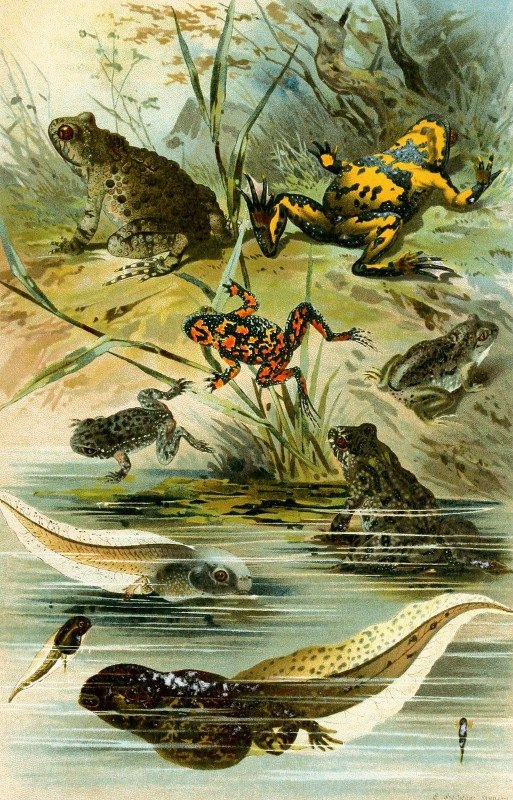
Bombinator pachypus, Bombinator bombinus, Alytes obst, Pelobates fuscus (1897). Bruno Dürigen (German, 1853–1930)
#amphibians#toads#Apennine yellow-bellied toad#European fire-bellied toad#spadefoot toads#Bruno Dürigen
138 notes
·
View notes
Photo

a toad!!! that i done drawn!!!
european fire-bellied toad (Bombina bombina) drawn in adobe photoshop.
rb’s r appreciated !! this took me a Very Long Time
links: this is on redbubble, if u want to wear it for some reason. my instagram (this isn’t usually what i post tho)
19 notes
·
View notes
Text
[ID : Thirty-one stills from Animal Fact Files videos with summary sentences and durations as white text over the images. A wide brown kissing bug (beetle) with "I kiss you... on the mouth". A brown kangaroo with "I am perpetually pregnant". A dark green, pale yellow- and red-spotted fire belly toad with "I smell like onions". A pale blue, wide yellow-beaked shoebill (bird) with "I probably killed my sibling". A purple and magenta crown of thorns starfish with "I'm hated". A blue-tinged, spotted, dark with a white belly ocean sunfish with "I'm covered in parasites". A black-spotted yellow spiny orb weaver (spider) with "I should not exist". A brown and white swan goose with "I am a lawn mower". A blue-gray mottled with red oscar (fish) with "I can rapidly change color". A black-eyed brown rain frog with "I squeak when I'm angry". A black-faced, tan-bodied pudu (deer) with "I'm the smallest living deer". A translucent blue box jellyfish with "I have eyes but no brain". A light blue, red-breasted European robin with "I protect my home with song". A yellow-spotted dark brown, red-breasted piranha (fish) with "I've never killed a human". A pale pinkish bearded dragon (lizard) with "I can make venom". A compact, dark brown Malaysian tapir (ungulate) with "I will eat your dreams". A mottled white-and-brown mimic octopus with "I'm a snake, no I'm a fish, no I'm..." A red rock crab with "I share my name". A brown skua (bird) with "I'm a pirate". A pale purple sea snail with "I build a raft of spit". A red trap jaw ant with "I jump with my jaws". A red-eyed black demoiselle crane (bird) with "I'm the smallest crane". An orange with black ring-like spots electric ray (fish) with "I'm 1/6th electric". A dark green caiman (reptile related to alligators) with "I have an orange mouth". A bright green, leaf-shaped katydid (bug) with "I'm the sound of the night". A yellow evening grosbeak (bird) with "I moved to the coast". A pale blue pleco (armored suckermouth catfish) with "I suck". A brown-shelled pale green sea turtle with "I have scutes (usually)". A black-eared white opossum with "I'm North America's only living marsupial". A pale yellow-white bone worm with a red mess at one end with "I eat whale bones". A black, prong-headed stag beetle with "I am an airhead". /end ID]










Daily affirmations
32K notes
·
View notes
Text

I recently introduced a new friend to my art blog and she liked my frogs so much she asked me to design a 'nerdy' one, so here's what I came up with! She's a European fire-bellied toad (no reason, just hadn't used one for a design yet).
She has a Dragon Quest Slime sticker on her Switch and a Stephen King book (as if its possible to tell xD) because those sure two things the requester had mentioned playing/reading recently 🐸
(I wondered as I made this if anyone would be interested in commissioning me to design characters like this? Feel free to comment or message me if you'd be interested in that <3)
1 note
·
View note
Text
@adstfu thx for tagging, luv u very much, congratulations for being first person which tag game I actually completed and posted
rules: answer all questions and tag random people and shit
name: Daria, though i rarely use it, usually going by my last name or various nicknames.
zodiac sign: shit wreck that is saggitarius
height: 164cm I think, I can't make short people jokes nor tall people jokes and I'm in hell
languages spoken: polish, english, german if I try (though my vocabulary needs improvement), basic czech and russian
nationality: polish, I'm from land of nationalism and onions
fave fruit: i would go with pomegranate, it's tasty, stains everything and reminds me of Persephone and I love this bitch
fave scent: soil after rain in fall and smell of bonfire made of conifers wood
fave colour: olive green
fave animal: my inner 12yo yells artic fox, my 15yo yells opossum, my 20yo self yells European fire bellied toad
coffee, tea or hot chocolate: I'm a green tea bitch
fave fictional character: gonna do random fav 5 beacuse I'm unable to choose: Allen Walker from D. Grey-Man, Greed from FMA, Nadia from The Arcana Game, Amy Santiago from B99, Moira from OW
dream trip: PERU PERU PERU PERU
song u have on repeat: Ruler of Everything by Tally Hall
what was the last movie u saw: Like Father, pretty ok
fave candy: irysy. it's a type of toffie and my favs had sesame seeds inside and they were soo good
fave holiday: all souls day, mostly beacuse its the most chill one and you can just sit and dwell
Tagging @elarko @ahumblepotatofarmer @wheeeek @mnzilla @just-do-it-never
#Tagged peeps I know from chat or notifications#Don't feel pressure to do it#Love ya#Tag game#Sznyc talks
3 notes
·
View notes
Photo


A red-bellied toad [Melanophryniscus dorsalis], a close relative to the bumblebee walking toad, displays its bright red hands and feet in a defensive posture known as unkenreflex. [”Unke” is German for the genus Bombina, such as Bombina bombina, the European fire-bellied toad.] Unkenreflex refers specifically to some amphibian’s behavior of contorting their bodies to reveal previously hidden colors when under threat of predation. The sudden appearance of apostematic coloring serves to warn predators of their toxicity. While it may be named after toads, many species of salamanders and newts have also adapted this reflex. Images by Axel Kwet.
1K notes
·
View notes